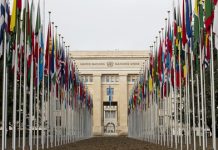Ahead of the General Assembly’s high-level meeting on AMR on 26 September, here’s what you need to know:
What is AMR?
Since their discovery a century ago, antimicrobial medicines, from antibiotics to antivirals, have significantly extended average life expectancy. Every day, these essential medicines save millions of lives, until they don’t.
AMR occurs when microorganisms like bacteria, viruses, fungi and parasites no longer respond to antimicrobial medicines. As a result of drug resistance, antimicrobial medicines become ineffective and infections become difficult or impossible to treat, increasing the risk of disease spread, severe illness, disability and death, according to the UN’s World Health Organization (WHO).
Similar to COVID-19, drug-resistant infections know no borders, and no one is immune. But, the incidence is higher in low to middle-income countries.
The threat from antimicrobial resistance is growing.
WHO: ‘It can happen to anyone’
Behind every number tracking AMR, there is a real, human cost. Some of the mounting burdens faced include limited treatment options, extended hospital stays, constant medication, prolonged loss of income, medical debt, poverty, family loss and grief. Lives are seriously impacted, in some cases fatally.
“It can happen to anyone, anywhere,” according to the UN health agency.
Even if you’re in good health, a minor injury, routine surgery or a common lung infection could unexpectedly escalate into a life-threatening situation. For those with pre-existing conditions like cancer, HIV or diabetes, an untreatable infection could emerge as a dangerous second threat, striking when least expected.
What’s driving it?
Several factors can accelerate the emergence and spread of AMR, with overuse of antibiotics being a key driver.
Overuse and misuse of antimicrobials: Using antibiotics when not necessary, over-prescription by healthcare providers and incomplete courses of treatment can all contribute to resistance.
Agricultural use: The use of antibiotics in livestock to promote growth and prevent disease can lead to resistant strains that can be transmitted to humans.
Poor infection control: Inadequate sanitation and hygiene in healthcare settings and communities facilitate the spread of resistant microorganisms.
Global trade and travel: Increased movement of people and goods allows resistant organisms to spread more easily across borders.
A doctor reviews a sample at a microbiology laboratory in a teaching hospital in Nigeria.
Consequences of AMR
The rise of AMR has serious implications for personal and public health.
AMR threatens both the lives of millions and our economic future. It also impacts food systems, development and security.
It could carry an estimated global annual cost of up to $3.4 trillion by 2030, pushing around 28 million people into poverty by 2050, according to the World Bank.
Global action plan
The good news is that AMR is 100 per cent preventable. International partners adopted a Global Action Plan in 2015 and have amplified public awareness raising, responsible antimicrobial use and continuous research.
Another effective tool is to reduce the need for antimicrobials by strengthening health systems through universal health coverage to prioritise infection prevention and control, immunisation and water, sanitation and hygiene (WASH) programmes.
For its part, WHO is monitoring, reporting and providing updates on drug-resistant microorganisms. For example, earlier this year, it updated its list of the drug-resistant bacteria most threatening to human health.
“Since the first Bacterial Priority Pathogens List was released in 2017, the threat of antimicrobial resistance has intensified, eroding the efficacy of numerous antibiotics and putting many of the gains of modern medicine at risk,” Dr. Yukiko Nakatani, WHO’s Assistant Director-General for Antimicrobial Resistance, said at the release in May of its latest list.
“By mapping the global burden of drug-resistant bacteria and assessing their impact on public health, this list is key to guiding investment and grappling with the antibiotics pipeline and access crisis,” she stressed.
Who’s taking action to stop AMR?
Scientists in Argentina study bacteria samples to track and control the emergence of antimicrobial resistance (AMR).
- World leaders will gather at the UN General Assembly’s high-level meeting on AMR in September to approve a political declaration.
- The Quadripartite Joint Secretariat on AMR consolidates cooperation between the Food and Agriculture Organization (FAO), UN Environment Programme (UNEP), WHO and the World Organisation for Animal Health (WOAH), drawing on their core mandates to support the global response to AMR across the One Health spectrum.
- WHO rolled out the global AMR is invisible. I am not.campaign to raise public awareness earlier in 2024 and runs a World AMR Awareness Week every year, from 18 to 24 November.
- WHO launched a task force of survivors to give a platform for and elevate the voices of those with experience of complications from drug-resistant infections.
- Read WHO’s factsheet on AMR here.
Source of original article: United Nations (news.un.org). Photo credit: UN. The content of this article does not necessarily reflect the views or opinion of Global Diaspora News (www.globaldiasporanews.net).
To submit your press release: (https://www.globaldiasporanews.com/pr).
To advertise on Global Diaspora News: (www.globaldiasporanews.com/ads).
Sign up to Global Diaspora News newsletter (https://www.globaldiasporanews.com/newsletter/) to start receiving updates and opportunities directly in your email inbox for free.






























